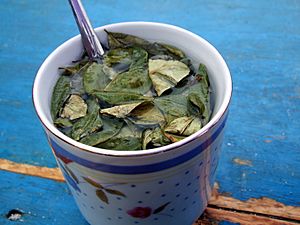Coca tea facts for kids
Coca tea, also known as mate de coca, is a special herbal drink. It's made from the fresh or dried leaves of the coca plant, which grows naturally in South America. To make it, you simply put coca leaves or a tea bag with coca leaves into hot water.
This tea is very popular in the Andes mountains, especially in countries like Argentina, Bolivia, Colombia, Ecuador, and Peru. It has a greenish-yellow color and tastes a bit bitter, similar to green tea, but with a slightly sweet, earthy flavor.
Even though it's sometimes called mate, mate de coca is quite different from the yerba mate drink that people enjoy in southeastern South America.
What's in Coca Tea?

The leaves of the coca plant contain natural substances called alkaloids. The amount of these alkaloids in the raw leaves is quite small. For example, a cup of coca tea made from one gram of coca leaves (which is usually what's in a tea bag) has only about 4.2 milligrams of a specific coca alkaloid.
Because of these alkaloids, coca tea acts as a mild stimulant. This means it can make you feel a bit more awake and energetic, much like drinking a regular cup of coffee or tea.
Just like how some coffee is made "decaffeinated" to remove most of the caffeine, coca tea can also be made "decocainized." This process removes most of the coca alkaloids. Even after this process, a very small amount of the alkaloids might still remain, similar to how decaffeinated coffee still has a tiny bit of caffeine.
Is Coca Tea Legal?
Coca tea is legal in several South American countries, including Colombia, Peru, Bolivia, Argentina, and Ecuador. However, it is not legal in the United States unless it has been decocainized (meaning most of the coca alkaloids have been removed).
Traditional Uses and Health Benefits
Many Andean people, especially indigenous communities, have used coca tea for a long time for traditional and health purposes.
Travelers visiting the Andes mountains are often told to drink coca tea to help prevent altitude sickness. This is a common problem when people go to high places where there is less oxygen. While many people believe it helps, scientists are still studying how effective it truly is.
See also
 In Spanish: Mate de coca para niños
In Spanish: Mate de coca para niños


